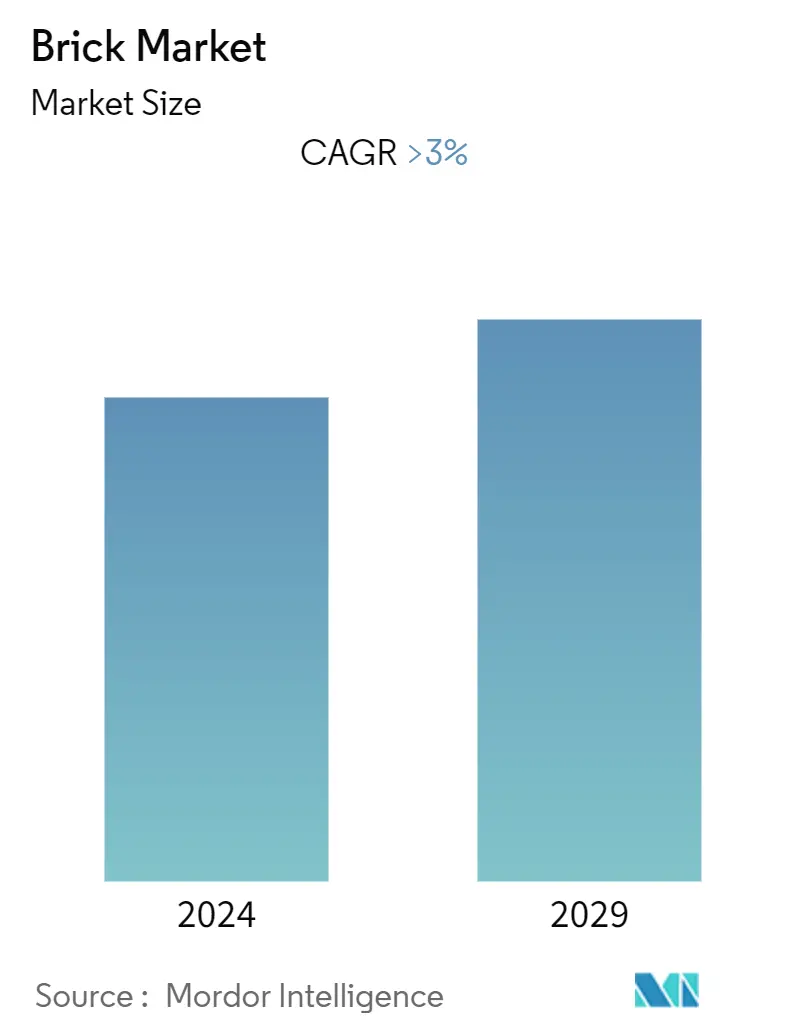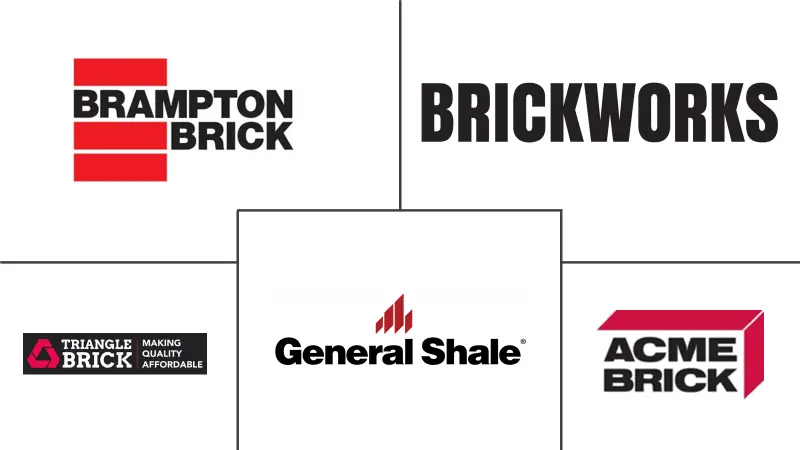Market Size of Brick Industry

| Study Period | 2019 - 2029 |
| Base Year For Estimation | 2023 |
| CAGR (2024 - 2029) | > 3.00 % |
| Fastest Growing Market | Asia Pacific |
| Largest Market | Asia-Pacific |
| Market Concentration | Low |
Major Players
*Disclaimer: Major Players sorted in no particular order |
Brick Market Analysis
The Brick Market is expected to register a CAGR of greater than 3% during the forecast period.
COVID-19 negatively impacted the market in 2020 and 2021. All the construction work and other activities were put on hold to curb the spreading of the virus, thereby negatively affecting the market. However, the market is projected to grow steadily in the coming years, owing to increased building and construction activities.
- Over the short term, the primary factor driving the brick market's growth is the building segment's high demand.
- On the flip side, increasing trends of prefabricated construction components are expected to restrain the market's growth.
- Furthermore, the development of new materials for bricks and increasing trends of customized bricks are likely to act as an opportunity for the market over the forecast period.
- Asia-Pacific is expected to remain the largest market due to the region's large-scale production and consumption of brick products.
Brick Industry Segmentation
Brick is a type of block used for building walls, pavements and other elements in masonry and building construction. The brick market is segmented by brick type, Application, and geography. By Brick Type, the market is segmented into Clay, Sand Lime, Fly-ash Clay, and Other Brick Types. , The market is segmented by Applications: Buildings, paths, Parterre, and Other Applications. The report also covers the market size and forecasts for the brick market in 15 countries across major regions. For each segment, the market sizing and forecasts have been done on revenue (USD million).
| Brick Type | |
| Clay | |
| Sand Lime | |
| Fly-ash Clay | |
| Other Brick Types |
| Application | |
| Buildings | |
| Path | |
| Parterre | |
| Other Applications |
| Geography | |||||||
| |||||||
| |||||||
| |||||||
| |||||||
|
Brick Market Size Summary
The brick market is poised for steady growth, driven by the increasing demand in the building segment. Despite the initial setbacks caused by the COVID-19 pandemic, which halted construction activities and negatively impacted the market, the industry is expected to recover and expand. The primary catalyst for this growth is the rising urbanization and the burgeoning demand for both residential and non-residential buildings. Bricks remain a fundamental component in the construction of various structures, and as global infrastructure development continues, the demand for bricks is anticipated to rise. However, the market faces challenges from the growing trend of prefabricated construction components, which could potentially restrain its expansion. Nonetheless, innovations in brick materials and the customization of bricks present significant opportunities for market players.
Asia-Pacific is projected to maintain its dominance in the brick market, largely due to the region's substantial production and consumption of brick products. Countries like China, India, Japan, and Indonesia are at the forefront of this growth, with rapid urbanization and significant investments in the construction sector. China, in particular, leads the global construction market, with substantial spending on building projects. Similarly, India is expected to become one of the largest construction markets, further bolstering the demand for bricks. The fragmented nature of the brick market sees numerous players, including Acme Brick Company, Brickworks, and GENERAL SHALE, INC., actively participating in the industry. Recent strategic moves, such as acquisitions and new factory setups, indicate a dynamic market landscape, poised for further development during the forecast period.
Brick Market Size - Table of Contents
-
1. MARKET DYNAMICS
-
1.1 Drivers
-
1.1.1 Growing Demand from the Building Segment
-
1.1.2 Other Drivers
-
-
1.2 Restraints
-
1.2.1 Increasing Trends of Prefabricated Construction Components
-
1.2.2 Other Restraints
-
-
1.3 Industry Value Chain Analysis
-
1.4 Porter's Five Forces Analysis
-
1.4.1 Threat of New Entrants
-
1.4.2 Bargaining Power of Buyers
-
1.4.3 Bargaining Power of Suppliers
-
1.4.4 Threat of Substitute Products and Services
-
1.4.5 Degree of Competition
-
-
-
2. MARKET SEGMENTATION (Market Size by Value)
-
2.1 Brick Type
-
2.1.1 Clay
-
2.1.2 Sand Lime
-
2.1.3 Fly-ash Clay
-
2.1.4 Other Brick Types
-
-
2.2 Application
-
2.2.1 Buildings
-
2.2.2 Path
-
2.2.3 Parterre
-
2.2.4 Other Applications
-
-
2.3 Geography
-
2.3.1 Asia-Pacific
-
2.3.1.1 China
-
2.3.1.2 India
-
2.3.1.3 Japan
-
2.3.1.4 South Korea
-
2.3.1.5 Rest of Asia-Pacific
-
-
2.3.2 North America
-
2.3.2.1 United States
-
2.3.2.2 Canada
-
2.3.2.3 Mexico
-
-
2.3.3 Europe
-
2.3.3.1 Germany
-
2.3.3.2 United Kingdom
-
2.3.3.3 France
-
2.3.3.4 Italy
-
2.3.3.5 Rest of Europe
-
-
2.3.4 South America
-
2.3.4.1 Brazil
-
2.3.4.2 Argentina
-
2.3.4.3 Rest of South America
-
-
2.3.5 Middle-East and Africa
-
2.3.5.1 Saudi Arabia
-
2.3.5.2 South Africa
-
2.3.5.3 Rest of Middle-East and Africa
-
-
-
Brick Market Size FAQs
What is the current Brick Market size?
The Brick Market is projected to register a CAGR of greater than 3% during the forecast period (2024-2029)
Who are the key players in Brick Market?
Acme Brick Company, Brickworks, Triangle Brick Co., Brampton Brick and GENERAL SHALE, INC. are the major companies operating in the Brick Market.

